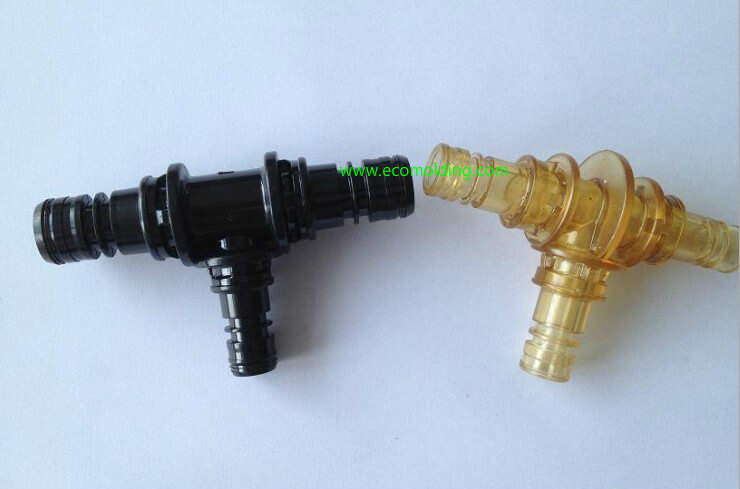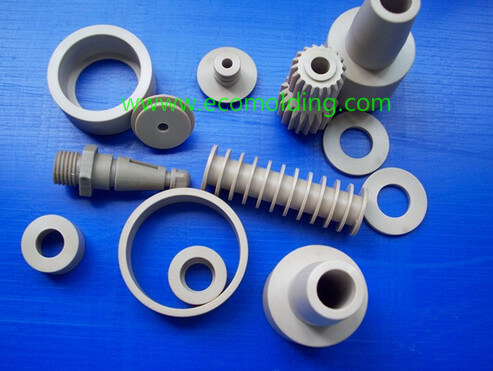In the field of high-temperature resins, there are diversified options, among which PEEK (Victrex), PPA (Amodel), PAI (Torlon), PPS (Ryton, Fortron), PPSU (Solvay), PEI (Ultem) and a number of other engineered grades are some of the commonly used ones. At Eco Molding, our engineers work with a selection of high-temperature resin materials, and we are able to obtain the resins in a diversity of color options.
C HARACTER OF HIGH TEMPERATURE MOLDING:
 Nowadays, high-heat plastic materials offer not only excellent physical & dimensional stability, but also outstanding elasticity. It is proved that they are resistant to harsh chemical and hydrolysis conditions, while another benefit of these high-performance plastic resins is that they feature exceptional electrical properties but very low smoke and flame toxicity, making additives totally unnecessary.For high-temperature molding process with undercut, finish, drafts and the type of steel integrated into the model from the very beginning, design is of critical importance.The dedicated high-temperature cell of Eco Molding is put into operation under the most stringent safety guidelines with equipment specially engineered to run at temperatures of as high as 850°F, with mold temperatures of up to 460°F.Ceramic heater bands, special thermolators and a unique mold base system are applied to modify the presses, helping Eco Molding achieve the clamping forces that range from 50 tons to 350 tons.
Nowadays, high-heat plastic materials offer not only excellent physical & dimensional stability, but also outstanding elasticity. It is proved that they are resistant to harsh chemical and hydrolysis conditions, while another benefit of these high-performance plastic resins is that they feature exceptional electrical properties but very low smoke and flame toxicity, making additives totally unnecessary.For high-temperature molding process with undercut, finish, drafts and the type of steel integrated into the model from the very beginning, design is of critical importance.The dedicated high-temperature cell of Eco Molding is put into operation under the most stringent safety guidelines with equipment specially engineered to run at temperatures of as high as 850°F, with mold temperatures of up to 460°F.Ceramic heater bands, special thermolators and a unique mold base system are applied to modify the presses, helping Eco Molding achieve the clamping forces that range from 50 tons to 350 tons.
A PPLICATION OF HIGH TEMPERATURE MOLDING:
More and more clients are seeking to create complicated items and parts from high-heat resin materials for applications in high-temperature environments, such as using a lightweight plastic automotive part to replace a metal part in a high-temperature operation environment. For applications in  higher temperatures, the plastic materials are able to keep tolerances of +/-.0005in, while maintaining excellent dimensional stability. Among the many other physical benefits of high-temperature resins, one of the most substantial one is their enhanced chemical resistant features. For instance, by virtue of its outstanding resistance to hydrolysis, the high-heat plastic polysulfone is an ideal replacement for brass in production of water fixtures.Though high-heat resin materials are more costly when compared with commodity-grade ones, they are able to greatly enhance product durability and performance, and thus remarkably reducing total production costs. For example, plastic parts are often used to replace metal parts which require costly and high-precision machining, so as to lower production costs, save time and strengthen resistance to corrosion. High-heat plastic parts usually cost much less than their metal counterparts, thanks to the fact that large quantity of plastic parts can be produced in a fast and easy way once the mold is developed and finely tuned. Therefore, it is a much more time-/cost-efficient process when compared with machining individual metal parts. Also, unlike metal parts, plastic ones are able to avoid the need for secondary finishing operations by virtue of their outstanding corrosion resistant properties.
higher temperatures, the plastic materials are able to keep tolerances of +/-.0005in, while maintaining excellent dimensional stability. Among the many other physical benefits of high-temperature resins, one of the most substantial one is their enhanced chemical resistant features. For instance, by virtue of its outstanding resistance to hydrolysis, the high-heat plastic polysulfone is an ideal replacement for brass in production of water fixtures.Though high-heat resin materials are more costly when compared with commodity-grade ones, they are able to greatly enhance product durability and performance, and thus remarkably reducing total production costs. For example, plastic parts are often used to replace metal parts which require costly and high-precision machining, so as to lower production costs, save time and strengthen resistance to corrosion. High-heat plastic parts usually cost much less than their metal counterparts, thanks to the fact that large quantity of plastic parts can be produced in a fast and easy way once the mold is developed and finely tuned. Therefore, it is a much more time-/cost-efficient process when compared with machining individual metal parts. Also, unlike metal parts, plastic ones are able to avoid the need for secondary finishing operations by virtue of their outstanding corrosion resistant properties.
